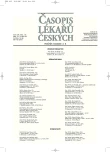Faktory asociované s vývojem agresivity chlapců
Factors Associated with Development of Boy’s Aggressiveness
Background.
There is no doubt about the aggressiveness increase in the population. All mass-media keep informing us about this problem. Based on the project ELSPAC data we considered participation in a brawl as an expression of aggressiveness and estimated its gravity depending on the place of treatment. From the information given in the questionnaire (wide variety of information about the respondent’s family, upbringing, health and psychic condition) we searched for relationships between these injuries and their gravity.
Methods and Results.
894 men out of 4,5 thousand ELSPAC study participants in Brno and the Znojmo district gave information about their injuries from brawls and they also stated if they were treated with the injury on the hospital bed, as an outpatient or only at home. The vast majority of the injuries happened between their 16th – 18th year of age.
Conclusions.
Dysfunctional family, ineffective upbringing, scholarity defects, low education, higher morbidity in the personal history together with the higher up-to-date accident rate of the respondent and his family members were assessed as factors associated with brawl injury occurence. The injury gravity was however less often associated with these factors than the injury occurence.
Key words:
aggressiveness and family, aggressiveness and injury, brawl injuries, male aggressiveness, child aggressiveness, aggressiveness and stress, aggressiveness and education, aggressiveness and school.
Autoři:
L. Kukla 1,2; M. Bouchalová 1
Působiště autorů:
Výzkumné pracoviště preventivní a sociální pediatrie LF MU, Brno
1; Katedra klinických oborů, ZSF JČU, České Budějovice
2
Vyšlo v časopise:
Čas. Lék. čes. 2007; 146: 699-707
Kategorie:
Původní práce
Souhrn
Východisko.
O silném nárůstu agresivity v populaci není pochyb. Všechna mass-media nás o tomto problému informují. Na základě dat projektu ELSPAC jsme účast ve rvačce považovali za projev agresivity a dle místa ošetření úrazu usuzovali na jeho závažnost. Z údajů podaných v dotazníku (k bohatým informacím o rodině, výchově, zdraví a psychické kondici respondentů) byly hledány vztahy mezi výskytem těchto úrazů i jejich závažností.
Metody a výsledky.
Informace o svých úrazech ze rvaček podalo 894 mužů ze 4,5 tisíc respondentů studie ELSPAC v Brně a ve znojemském okrese, kteří zároveň uvedli, zda byli s úrazem ošetřeni na nemocničním lůžku, ambulantně nebo jen doma. K převážné většině úrazů došlo mezi 16–18 roky.
Závěry.
Rozvrácená rodina, slabost výchovy, defekty scholarity, nízké vzdělání, vyšší nemocnost v anamnéze spolu s vyšší dosavadní úrazovostí respondentů i členů jejich rodin byly zjištěny jako faktory asociované s výskytem úrazů ze rvaček. Závažnost úrazů však byla s těmito faktory asociována méně často než jejich výskyt.
Klíčová slova:
agresivita a rodina, agresivita a úraz, úrazy ze rvaček, agresivita mužů, dětská agresivita, agresivita a zdraví, agresivita a stres, agresivita a vzdělání, agresivita a škola.
Štítky
Adiktologie Alergologie a imunologie Angiologie Audiologie a foniatrie Biochemie Dermatologie Dětská gastroenterologie Dětská chirurgie Dětská kardiologie Dětská neurologie Dětská otorinolaryngologie Dětská psychiatrie Dětská revmatologie Diabetologie Farmacie Chirurgie cévní Algeziologie Dentální hygienistkaČlánek vyšel v časopise
Časopis lékařů českých

- Psilocybin a neurodegenerace: Kam míří současný výzkum?
- Ukažte mi, jak kašlete, a já vám řeknu, co vám je
- Neuropatie u diabetu: Proč ji nepřehlédnout a kdy myslet i na deficit vitaminů B?
- Metamizol jako analgetikum první volby: kdy, pro koho, jak a proč?
- FDA varuje před selfmonitoringem cukru pomocí chytrých hodinek. Jak je to v Česku?
Nejčtenější v tomto čísle
- Genotypizace cytochromu P450 2D6 a 2C19
- Problematika krčkových defektů ve stomatologii
- Analýza vlivu cirkadiánního rytmu na turbulenci srdeční frekvence u pacientů s poinfarktovou dysfunkcí levé srdeční komory
- Funkční a vývojový pohled na systém Purkyňových vláken

